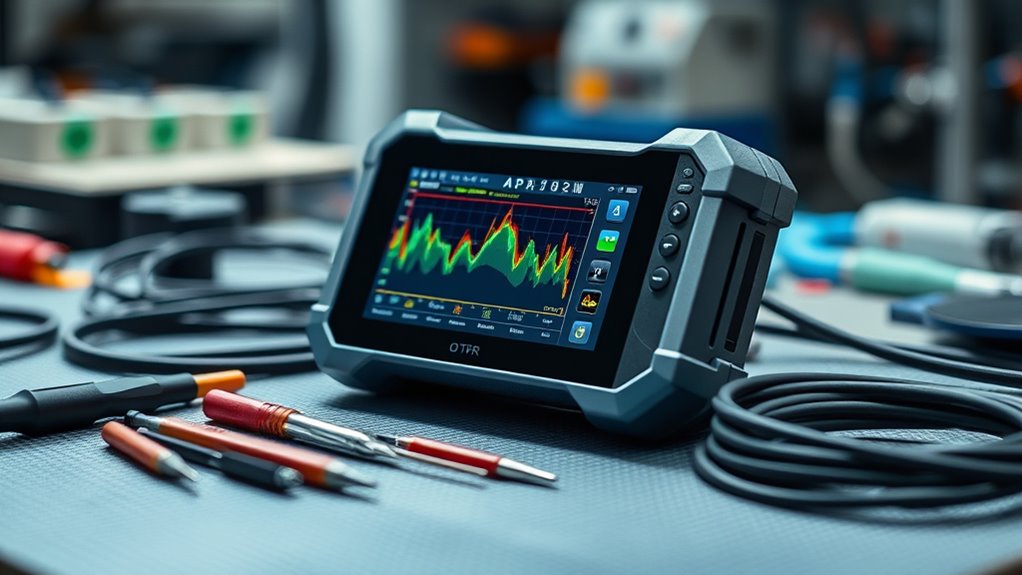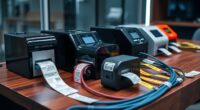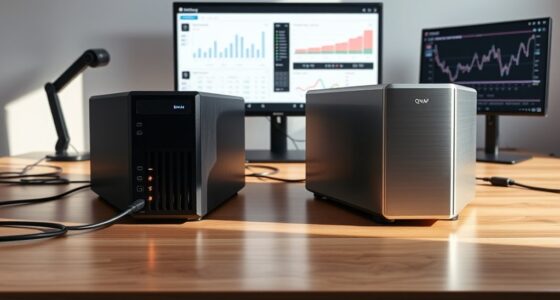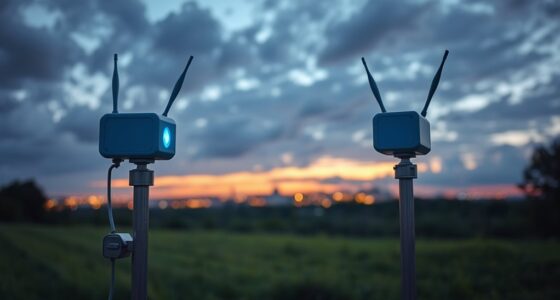If you’re searching for the 14 best portable OTDR testers in 2025, I’ve got you covered. These devices range from compact mini-pro models to versatile all-in-one solutions, supporting multiple wavelengths and long-range testing. They’re designed for fast, precise fiber analysis, fault detection, and network troubleshooting in the field. Whether you need rugged durability or integrated tools, these testers meet a variety of needs. If you’re interested, stick around to discover more about their features and benefits.
Key Takeaways
- The top portable OTDR testers in 2025 feature multi-wavelength support, long testing ranges, and high dynamic range for precise fiber analysis.
- Modern models incorporate user-friendly touchscreens, detailed event maps, and comprehensive report generation for efficient troubleshooting.
- These testers combine multiple functions like power measurement, cable tracing, and network testing in lightweight, durable designs.
- Advanced options include WiFi, Ethernet connectivity, and wireless charging, enabling seamless data transfer and extended field use.
- The best devices are tailored for diverse environments, offering quick setup, accurate fault localization, and versatile testing capabilities.
Mini-Pro OTDR Tester with OPM/OLS, RJ45, VFL, 5m-60km Range
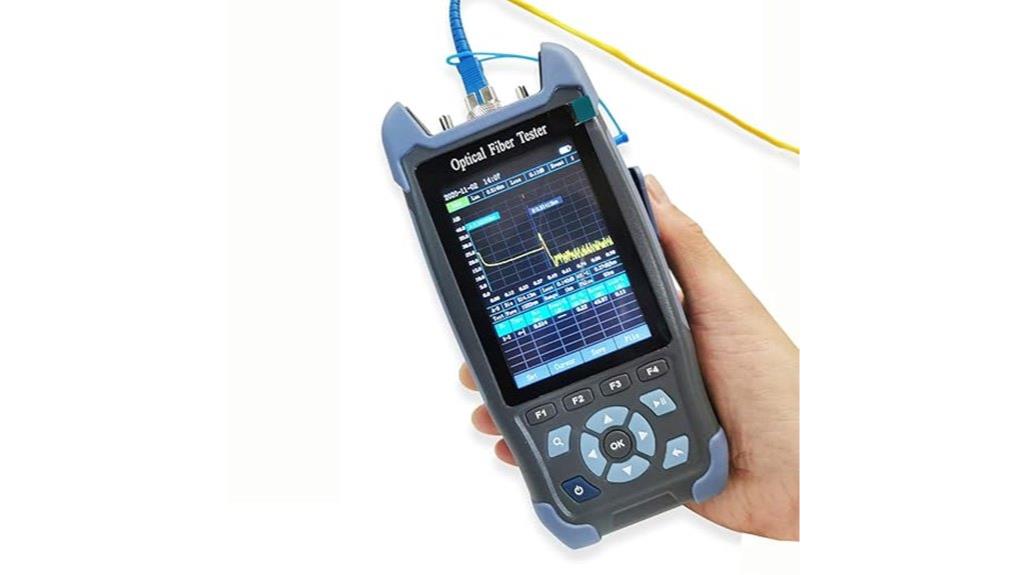
If you’re looking for a versatile, portable OTDR tester that’s perfect for on-the-go fiber optic testing, the Mini-Pro OTDR Tester is an excellent choice. It features a 1310/1550nm wavelength range, with a test span from 5 meters up to 60 kilometers, making it suitable for various applications. The built-in OPM/OLS, RJ45 port, and VFL add to its multifunctionality, helping you identify fiber issues quickly. Its 3.5-inch color display provides clear visuals, and the internal and external storage options assure your data is safe. Designed for professionals, this tester delivers reliable results for fiber characterization, maintenance, and troubleshooting in the field.
Best For: professionals conducting on-the-go fiber optic testing, maintenance, and troubleshooting in the field.
Pros:
- Versatile multifunctionality with OTDR, Power Meter, Cable Length, and RJ45 testing features
- Portable and lightweight design ideal for field use with a 3.5-inch color display for clear visuals
- Wide testing range from 5 meters to 60 kilometers, suitable for various applications
Cons:
- Non-touch display may be less user-friendly compared to touchscreen models
- Accuracy may be limited for very high-precision requirements, requiring more advanced equipment
- Software analysis requires installation on a PC, which may be inconvenient for some users
WANLUTECH OTDR Fiber Optic Tester with VFL and Network Testing
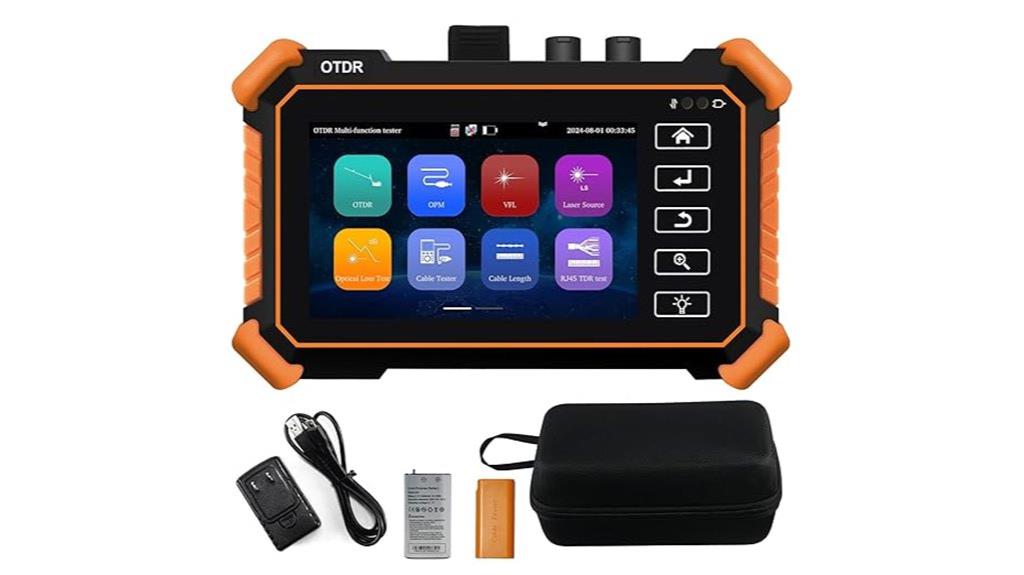
The WANLUTECH OTDR Fiber Optic Tester with VFL and Network Testing stands out as an ideal choice for technicians who need reliable, all-in-one fiber and network testing on the go. It features a singlemode OTDR with 1310nm/1550nm wavelengths, offering a 26dB/24dB dynamic range, and quick setup options for precise measurements. Integrated functions include a calibrated optical power meter, VFL, light source, and optical loss testing, making it versatile for various tasks. The device also provides graphical event maps, detailed reporting, and extensive network tests like IP scanning and PING. Its 4-inch touchscreen and portable design ensure ease of use in the field.
Best For: technicians and network professionals seeking a comprehensive, portable fiber optic and network testing solution in a single device.
Pros:
- Combines multiple testing functions (OTDR, power meter, VFL, light source) in one portable unit for convenience.
- Features graphical event maps and detailed report generation for efficient diagnostics.
- Supports extensive network testing capabilities including IP scan, PING, and cable length measurement.
Cons:
- Cannot test live fiber, limiting its use in active network environments.
- Small 4-inch touchscreen may be less comfortable for prolonged use or detailed navigation.
- Battery life may require frequent recharging during extensive field work.
Mini-Pro OTDR Tester with OPM/OLS, RJ45, VFL, 5m-60km Range

For professionals seeking a versatile and reliable handheld fiber optic testing tool, the Mini-Pro OTDR Tester with OPM/OLS, RJ45, VFL, and a 5m-60km range stands out as an ideal choice. It’s designed for evaluating FTTx and access networks, pinpointing fiber breakpoints, measuring cable length, and calculating optical power loss. Its 1310/1550nm wavelengths and up to 60km range accommodate various testing scenarios. The device features a 3.5-inch color display, multiple functions like OTDR and cable tracking, and supports internal and external data storage. Its rugged build and all-encompassing software make it perfect for fieldwork and detailed analysis.
Best For: professionals conducting fiber optic network installation, maintenance, and troubleshooting who need a versatile, portable testing device with multiple functions and a broad range.
Pros:
- Combines OTDR, power meter, cable length measurement, and cable tracker in one compact device.
- Supports multiple wavelengths (1310/1550nm) and a testing range of 5m-60km for versatile applications.
- Features a 3.5-inch color display and comprehensive data storage options for easy field analysis.
Cons:
- Non-touch screen may be less intuitive compared to modern touchscreen devices.
- Requires software installation on a PC for data analysis, which may add setup time.
- Slightly limited accuracy for some high-precision measurements compared to dedicated high-end testers.
Compact OTDR Cable Box with SCUPC to LCUPC Interface

Designed specifically for fiber optic technicians on the move, the Compact OTDR Cable Box with SCUPC to LCUPC interface offers a reliable, portable solution for precise testing. Its lightweight, ABS construction guarantees durability and easy handling, while the press top design prevents cable tangling or damage. Equipped with a single-mode SCUPC to LCUPC interface, it’s optimized for 1310nm and 1550nm wavelengths, perfect for single-mode fiber testing. The device supports non-destructive fiber insertion and includes blind spot compensation for accurate measurements. With essentials like accessories and a lanyard, this compact box streamlines field testing without compromising accuracy or ease of use.
Best For: fiber optic technicians and professionals requiring portable, accurate testing solutions in the field.
Pros:
- Lightweight and durable ABS construction makes it easy to carry and resistant to damage.
- User-friendly press top design simplifies cable retrieval and prevents tangling.
- Supports non-destructive fiber insertion and blind spot compensation for precise measurements.
Cons:
- Contains non-removable interface tail fibers, which may limit flexibility in some setups.
- Designed primarily for single-mode fiber testing, less versatile for multimode applications.
- Limited to specific wavelengths (1310nm and 1550nm), potentially requiring additional tools for other testing needs.
Mini-Pro OTDR Tester with OPM/OLS, RJ45, VFL, 5m-60Km Range

If you’re seeking a versatile and portable OTDR tester that handles a wide range of fiber optic testing tasks, the Mini-Pro OTDR Tester with OPM/OLS, RJ45, VFL, and a 5m-60Km range stands out. It’s designed for evaluating FTTx, access networks, and maintenance, helping you identify fiber breakpoints, measure cable lengths, and calculate optical power losses accurately. Its 1310/1550nm wavelengths and up to 60 km range make it suitable for various scenarios. The device features a 3.5-inch color display, internal and external data storage, and multiple functions like cable tracking and power measurement. It’s a compact, professional-grade tool for precise fiber testing on the go.
Best For: professionals in fiber optic network installation, maintenance, and troubleshooting who need a portable, multi-functional tester for accurate fiber analysis.
Pros:
- Combines multiple testing functions (OTDR, Power Meter, Cable Tracker) in a compact device for convenience.
- Wide testing range from 5 meters to 60 kilometers suitable for various scenarios.
- Supports internal and external data storage with software for detailed analysis and reporting.
Cons:
- Non-touch display may be less intuitive compared to touchscreen models.
- Some testing scenarios require higher dynamic range (>42dB), which may limit accuracy in certain cases.
- Factory testing ensures quality, but users may need training to operate all functions effectively.
WANLUTECH OTDR Fiber Tester with Touchscreen (Support 1310/1490/1550/1577nm)

The WANLUTECH OTDR Fiber Tester with Touchscreen stands out as an ideal choice for professionals who need accurate, versatile fiber optic testing on the go. Its support for multiple wavelengths—1310, 1490, 1550, and 1577nm—allows thorough live testing and detailed event mapping with a 28dB dynamic range at 1610nm. The device offers fast setup, graphical fiber link visualization, and detailed reports in PDF or Excel. Integrated optical tools, including power meters, VFL, and light sources, enable complete fiber analysis. The 5.4-inch touchscreen, multiple connector options, and connectivity features make it a portable, all-in-one solution for precise fiber testing anywhere.
Best For: telecommunications technicians and network engineers seeking a portable, comprehensive fiber optic testing device with multi-wavelength support and advanced analysis features.
Pros:
- Supports multiple wavelengths (1310/1490/1550/1577nm) for versatile live testing and detailed event mapping at 1610nm.
- Integrates essential fiber optic tools such as power meter, VFL, light source, and OLTS in a single handheld device.
- Features a user-friendly 5.4-inch touchscreen, various connector options, and robust connectivity including WiFi and Gigabit Ethernet.
Cons:
- Requires removal of the paper sheet isolating the battery before first use.
- The device’s advanced features may have a learning curve for new users.
- High-quality professional testing may come with a higher cost compared to simpler testers.
Optical Fiber OTDR Testing and Optical Power Meter (OPM) Tester (SS305T-2A1)

For professionals who need reliable, accurate fiber optic testing on the go, the SKYSHL SS305T-2A1 stands out with its dual-wavelength OTDR capabilities and extensive testing functions. It supports 1310nm and 1550nm wavelengths, with a maximum test distance of 80 km, making it ideal for installation and maintenance. The device includes 12 functions, such as OTDR, event map, optical power meter, and fiber connection testing, all within a user-friendly design. Its advanced optical technology features ultra-short blind zones for short-distance fault detection. Compatible with various connectors and equipped with versatile adapters, the SS305T-2A1 guarantees precise and efficient fiber testing anywhere.
Best For: professionals requiring reliable, precise fiber optic testing in installation and maintenance environments with portable, multi-functional equipment.
Pros:
- Dual-wavelength OTDR (1310nm/1550nm) with ultra-short blind zones for accurate short-distance fault detection
- Supports multiple testing functions including OTDR, optical power meter, event map, and fiber connection testing
- User-friendly modes and extensive compatibility with various connectors and adapters for versatile field use
Cons:
- The device may require some training to fully utilize advanced features like OTDR and event map analysis
- Slightly higher cost due to multi-functionality and advanced optical technology
- Battery life and portability depend on usage intensity, which may require frequent recharging during extensive testing sessions
16-in-1 OTDR Optical Fiber Tester

The in-1 OTDR Optical Fiber Tester stands out as a versatile choice for fiber optic professionals who need all-inclusive testing in a compact device. It integrates 16 functions, including OTDR, optical power meter, visual fault locator, light source, OLTS, and network tools, all in a user-friendly design with a touch screen and wireless charging. Its OTDR capabilities cover wavelengths of 1310/1550nm, reaching up to 80 km, with automatic testing and detailed event maps for quick fault identification. The device’s extensive features support fiber installation, construction, and troubleshooting, making it a reliable, multi-purpose tool for on-site professionals.
Best For: fiber optic technicians and network professionals seeking an all-in-one device for installation, testing, and troubleshooting in the field.
Pros:
- Combines 16 functions including OTDR, optical power meter, VFL, and network tools for comprehensive testing in one device
- User-friendly interface with a touch screen and wireless charging for ease of operation on-site
- Supports long battery life with standby over 20 hours and measurement over 12 hours, ideal for extended field use
Cons:
- Some users report build quality issues and limitations with connectors
- External power supply recommended, with possible confusion about rechargeable battery status
- May be relatively expensive compared to single-function testers, depending on user needs
WANLUTECH OTDR Fiber Tester with Touchscreen and Network Tools

If you’re seeking a versatile and user-friendly fiber tester that combines precise measurement with network troubleshooting, the WANLUTECH OTDR Fiber Tester stands out. It features a 5.55-inch touchscreen and supports singlemode OTDR testing at 1550nm with a 24dB dynamic range, quick setup, and compatibility with multiple wavelengths like 1310/1490/1577/1625nm. It also offers optical loss testing, event mapping, and data storage with PDF and Excel report generation. Additionally, its network tools include IP scanning, PING, and FTP file management. With a built-in rechargeable battery, multiple adapters, and Ethernet connectivity, it’s a all-inclusive tool for fiber and network diagnostics in the field.
Best For: technicians and field engineers seeking a comprehensive, easy-to-use fiber and network testing device with precise measurement and troubleshooting capabilities.
Pros:
- Combines fiber optic testing, network diagnostics, and cable fault detection in one device.
- Supports multiple wavelengths and provides detailed event mapping with report generation.
- Features a user-friendly 5.55-inch touchscreen and built-in rechargeable battery for portability.
Cons:
- Packaging excludes the charging adapter, requiring an additional purchase.
- The device’s advanced features may require some training for optimal use.
- Limited to a 600m maximum testing length for RJ45 cables, which may be insufficient for very long runs.
OTDR A-900D Fiber Optic Tester with Accessories
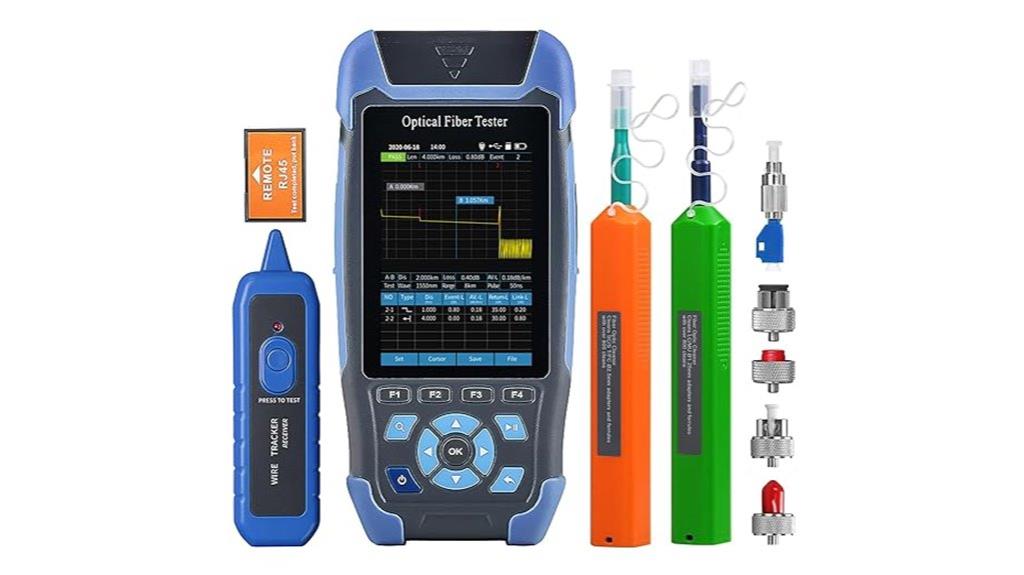
The OTDR A-900D Fiber Optic Tester with Accessories stands out as an excellent choice for professionals seeking a versatile, easy-to-use device capable of accurate fiber optic testing up to 60 km. It features a 9-in-1 design, combining OTDR, Power Meter, Light Source, VFL, and more in a single unit. The device supports testing at 1310/1550nm wavelengths with a dynamic range of up to 24dB, ensuring precise measurements even on challenging fibers. Its intuitive one-key operation, built-in 3.5-inch color display, and interchangeable connectors make it perfect for fieldwork. Plus, extensive data storage options and accessories like cleaning pens enhance its overall functionality.
Best For: professionals and field technicians seeking a versatile, user-friendly fiber optic testing device with comprehensive functions and reliable accuracy up to 60 km.
Pros:
- Combines 9 essential fiber optic testing functions in one portable device for convenience.
- Supports automatic one-key operation, making it suitable for beginners and reducing setup complexity.
- Includes extensive data storage options and accessories like cleaning pens for efficient field use.
Cons:
- Non-touch display may be less intuitive compared to modern touchscreens.
- Dynamic range of 24dB might be insufficient for some very challenging fiber environments requiring over 42dB.
- Limited to testing up to 60 km, which may not cover ultra-long-haul fiber applications.
Optical Fiber Tester with Touchscreen and Network Functions

A portable optical fiber tester with a touchscreen and advanced network functions is ideal for field technicians who need quick, accurate diagnostics without sacrificing connectivity. It features an 8-inch IPS touchscreen for easy navigation and offers thorough testing capabilities, including singlemode OTDR, optical loss measurements, and event mapping. The device supports SFP modules, cable tracing, PoE testing, and network tools like ping and IP scan, all in one unit. Dual gigabit Ethernet ports and built-in WiFi ensure seamless connectivity to networks. Its robust design, extensive accessory support, and detailed reporting make it a versatile tool for precise fiber troubleshooting and network management in the field.
Best For: Field technicians and network engineers seeking a portable, all-in-one fiber testing and network diagnostics device for quick, accurate troubleshooting in the field.
Pros:
- Combines multiple testing functions (OTDR, optical loss, cable tracing, PoE, network tools) into one portable unit.
- Features an intuitive 8-inch touchscreen and robust connectivity options including dual gigabit Ethernet ports and built-in WiFi.
- Supports comprehensive reporting with detailed graphs, event mapping, and format options (PDF, Excel).
Cons:
- Does not support live fiber testing, limiting its use for active fiber link verification.
- May require familiarity with multiple testing modes and settings for professional calibration.
- The device’s advanced features and accessories can increase overall cost and complexity for casual users.
Singlemode OTDR Fiber Optic Tester (WANLUTECH)

For technicians seeking reliable singlemode fiber testing, the WANLUTECH Singlemode OTDR Fiber Optic Tester stands out with its precise measurement capabilities at 1310nm and 1550nm wavelengths. It offers a broad range of 26dB and 24dB, enabling accurate detection over long distances. The device features quick setup options for wavelength, distance range, pulse width, and measurement duration, along with a mode for professional parameter adjustments to enhance curve accuracy. It also includes integrated functions like an optical power meter, visual fault locator, light source, and optical loss testing. Its graphical event maps, data storage, and reporting tools make it a extensive, portable solution for fiber verification.
Best For: technicians and network professionals requiring accurate, portable fiber optic testing and verification in singlemode environments without the need for live fiber testing.
Pros:
- Comprehensive testing features including OTDR, optical power meter, visual fault locator, and optical loss testing in one device.
- Quick setup and adjustable parameters for precise, professional curve and measurement accuracy.
- Graphical event maps, data storage, and detailed reporting capabilities facilitate thorough fiber link analysis.
Cons:
- Cannot test live fiber, limiting its use in active network environments.
- 4-inch touchscreen may be small for detailed viewing or extended operation.
- Limited to singlemode fiber testing, not suitable for multimode fiber applications.
New Upgraded OTDR Optical Fiber Tester

If you’re seeking a reliable tool for precise fiber optic testing, the newly upgraded OTDR Optical Fiber Tester stands out as an excellent choice. It offers versatile wavelength support at 1310nm and 1550nm with a dynamic range of 26dB and 24dB, respectively. The quick setup mode speeds up configuration, while the professional parameters set mode allows detailed customization. Its event map visually highlights faults, connectors, and breaks, making troubleshooting easier. With data storage for curves, analysis, and report creation, along with a compact, user-friendly design, this tester ensures accurate, efficient fiber optic testing in any field environment.
Best For: telecommunications technicians, fiber optic installers, and network engineers seeking precise, versatile fiber testing in the field.
Pros:
- Supports dual wavelengths (1310nm/1550nm) with high dynamic range for accurate measurements
- User-friendly touchscreen interface with quick and professional configuration modes
- Event map visualization simplifies fault detection and troubleshooting
Cons:
- Limited to optical fiber testing; does not include advanced network troubleshooting features
- Battery life, while substantial, may require frequent charging during extensive field use
- The device’s comprehensive features may have a learning curve for new users
Fiber Optic Cable Tester with Power Meter and Visual Fault Locator
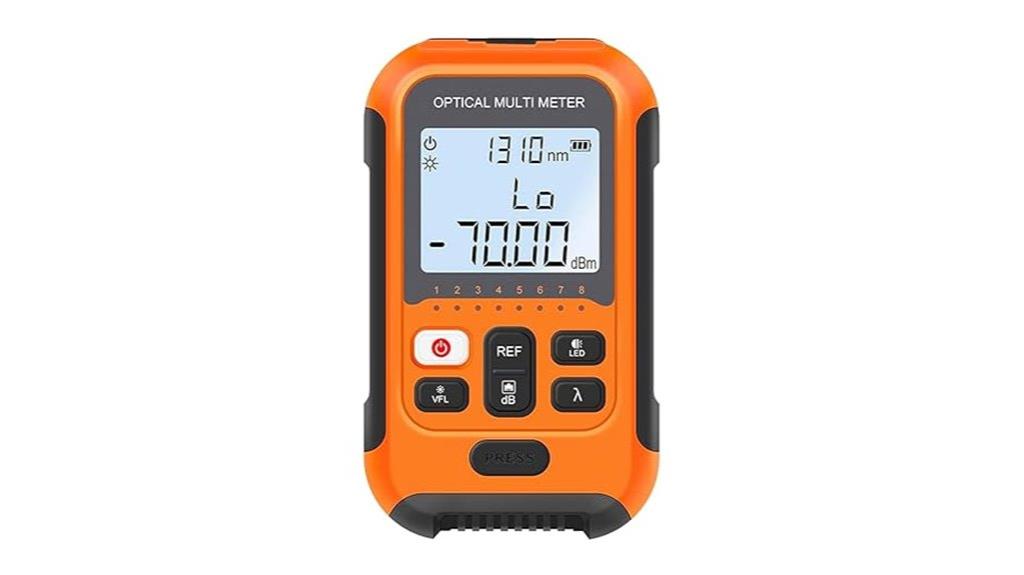
The Fiber Optic Cable Tester with Power Meter and Visual Fault Locator stands out as an ideal choice for professionals seeking an all-in-one testing solution. It combines an optical power meter and a visual fault locator in a portable design, supporting eight wavelengths from 850 to 1650 nm. With a testing range from -70 dBm to +6 dBm and a 2 mW VFL for fault detection, it simplifies fiber testing. Supporting universal FC/SC/ST interfaces and RJ45, it offers versatile measurements and simultaneous readings in mW and dBm. Its user-friendly features, including backlight, automatic shutdown, and calibration options, guarantee accuracy, durability, and ease of use in diverse testing scenarios.
Best For: telecommunications technicians and fiber optic professionals seeking a comprehensive, portable testing device for accurate fiber inspection and measurement.
Pros:
- Combines optical power meter and visual fault locator in one compact unit for convenience
- Supports eight wavelengths and multiple interface types for versatile testing options
- Features user-friendly functions like backlight, automatic shutdown, and calibration to enhance usability
Cons:
- May require initial training to fully utilize all functions effectively
- Limited to a testing range of -70 dBm to +6 dBm, which might not cover extremely low or high signal levels
- As an all-in-one device, it could be more expensive than separate units for specific tasks
Factors to Consider When Choosing a Portable OTDR Tester
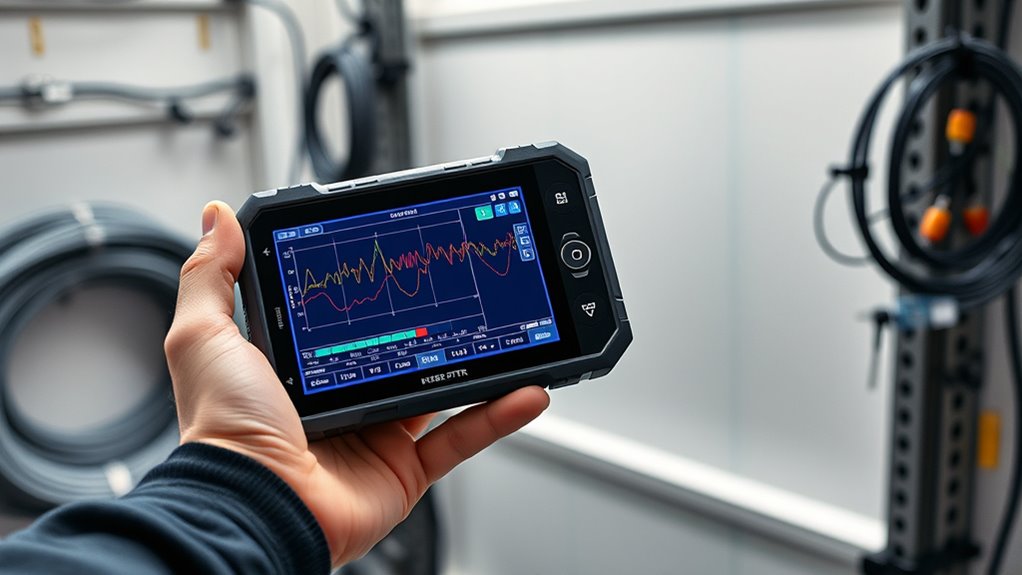
When selecting a portable OTDR tester, I focus on key factors like wavelength compatibility and measurement range to guarantee it fits my testing needs. Portability and data storage options also matter, especially for fieldwork. By considering these points, I can choose a device that offers accuracy and convenience in any situation.
Wavelength Compatibility
Selecting a portable OTDR tester with the right wavelength support is vital for accurate fiber optic testing. The most common wavelengths for singlemode fibers are 1310nm and 1550nm, so make sure your device covers these for standard testing. If your network involves hybrid or multi-wavelength systems, compatibility with additional wavelengths like 1490nm or 1625nm becomes important. Some testers allow live testing at specific wavelengths, which facilitates real-time diagnostics. Others support multi-wavelength measurements simultaneously, streamlining testing processes, while some require manual switching. Always verify that the supported wavelengths align with your network components and industry standards. Proper wavelength compatibility guarantees precise measurements and reliable troubleshooting, making it a key factor in selecting the best portable OTDR tester.
Measurement Range Needs
Choosing the right measurement range for your portable OTDR tester hinges on understanding your specific fiber testing needs. First, determine the maximum fiber length you need to test, as portable OTDRs typically cover from 5 meters up to 60 kilometers. If you’re working with splintered fibers, look for models with dynamic ranges over 42dB to ensure accurate fault detection and loss measurement. Match the device’s measurement range with your typical fiber run lengths—shorter ranges for local or premises networks, longer for long-haul links. Also, consider if your application requires testing both short-distance (a few hundred meters) and long-distance (tens of kilometers) fibers. Keep in mind, some testers may not handle very long fibers exceeding 60 km, limiting their suitability for certain projects.
Device Portability
A portable OTDR tester’s ease of use on the field depends heavily on its design and features. I look for a lightweight device, ideally under 2 kg, so I can handle it comfortably during long testing sessions. Compact dimensions, similar to a small tablet or smartphone, make it easy to transport and store in my toolkit or carrying case. A built-in rechargeable battery with high capacity, like over 4000mAh, allows me to perform extended tests without constantly searching for power sources. An integrated touchscreen display and minimal external accessories keep the device self-contained and simple to operate on-site. Additionally, durable construction with shock-absorbing materials and weather-resistant casing guarantees the tester withstands outdoor conditions, making it reliable in various environments.
Testing Accuracy
Ensuring testing accuracy with a portable OTDR requires paying close attention to several critical factors. First, I look for a high dynamic range, ideally 24dB or higher, to detect weak signals over long distances accurately. Minimizing blind zones—less than 1.6 meters for events and under 8 meters for attenuation—helps me pinpoint faults precisely. I also verify that the device supports the necessary wavelengths, such as 1310nm and 1550nm, which are standard for singlemode fibers. Precise parameter controls, like adjustable pulse width and measurement modes, allow me to tailor tests to specific fiber conditions. Lastly, I guarantee the tester’s calibration and measurement stability meet high standards, providing consistent, reliable results every time I use it.
Data Storage Options
When selecting a portable OTDR tester, I pay close attention to its data storage options because they directly impact how efficiently I can manage and analyze test results. Most models feature internal storage via micro USB or SD card slots, allowing me to save large volumes of data and fiber curves directly on the device. External storage options like TF cards or USB drives make it easy to transfer and back up results to computers. The capacity varies, with some testers supporting hundreds of test files, which suits extensive projects. Many devices include analysis software that imports stored data for detailed review, reporting, and documentation. Convenient features like automatic file naming, date stamping, and easy navigation help me organize and retrieve test data quickly, boosting my workflow efficiency.
Battery Life Duration
Long battery life is essential because it allows me to conduct extended testing sessions without constantly worrying about recharging. A portable OTDR with at least 8-12 hours of battery life is ideal for full-day projects and remote locations where power sources are limited. Devices with higher battery capacity, measured in milliampere-hours (mAh), tend to last longer, giving me more operational time between charges. Quick recharge times and power-saving features further maximize efficiency and reduce downtime, which is critical during tight schedules. When choosing a tester, I prioritize those that can sustain continuous use for a full workday or more, ensuring I can complete my testing without interruptions. This focus on battery life ultimately enhances my productivity and confidence in field conditions.
Additional Testing Features
Choosing a portable OTDR tester with the right additional features can considerably expand its usefulness beyond basic fiber fault detection. Features like visual fault locators with around 650nm wavelengths allow me to quickly pinpoint issues up to 8 km away. Built-in optical power meters calibrated at multiple wavelengths (such as 850, 1300, and 1550nm) help me measure power loss across various fiber types, ensuring thorough testing. Network testing functions like Ethernet, IP scanning, and cable continuity checks give me a broader diagnostic perspective, saving time on separate devices. Additional tools like optical loss testers, cable length measurement, and port testing enable a thorough assessment of network performance in one portable device. These features make my testing more efficient, accurate, and versatile in any field scenario.
Frequently Asked Questions
How Does the Battery Life Impact Field Testing Efficiency?
Battery life substantially impacts my field testing efficiency because it determines how long I can work without interruptions. A longer-lasting battery lets me perform extensive tests without worrying about recharging, saving time and preventing delays. When my OTDR’s battery drains quickly, I have to stop testing, find power sources, or carry extra batteries, which slows down my workflow. Reliable battery life is essential for smooth, efficient fiber optic testing in the field.
Can These Testers Operate Effectively in Extreme Environmental Conditions?
Imagine battling fierce winds or scorching heat while trying to get precise measurements. These testers are built tough, with rugged enclosures and temperature-resistant components, so I’ve found they operate effectively even in extreme conditions. Their durability means I don’t have to worry about environmental factors skewing results or damaging the device. This resilience allows me to focus on my testing, confident that the equipment will perform reliably no matter the weather.
What Are the Maintenance Requirements for Long-Term Reliability?
To guarantee my portable OTDR remains reliable long-term, I regularly clean the connectors and keep the device protected from dust and moisture. I also perform calibration checks as recommended by the manufacturer and store it in a sturdy case when not in use. Additionally, I avoid exposing it to extreme temperatures or rough handling, which helps maintain its precision and longevity over time.
How Compatible Are These Testers With Existing Fiber Network Infrastructure?
These testers are highly compatible with existing fiber network infrastructure because they support standard connectors and protocols. I find they easily integrate into most setups, whether it’s single-mode or multimode fibers. Plus, many models offer adaptable interfaces, making shifts seamless. Overall, I’d say they’re designed to work smoothly with current systems, ensuring accurate testing without needing extensive modifications.
Do These Testers Support Real-Time Data Sharing and Remote Diagnostics?
Yes, these testers support real-time data sharing and remote diagnostics. I find it incredibly useful because I can quickly send test results to my team or access diagnostics remotely, saving me time and improving troubleshooting efficiency. Their wireless connectivity and cloud integration make collaboration seamless, so I can focus on precise fiber optic testing without worrying about data transfer delays or gaps.
Conclusion
Choosing the right portable OTDR tester is like finding the perfect key for a complex lock—it opens your fiber optic testing with precision and ease. With options ranging from compact mini-Pro models to advanced singlemode testers, you’ll find the perfect fit for your needs. Remember, investing in quality tools guarantees your network stays strong and reliable, guiding you through the intricate maze of fibers with confidence and clarity.
